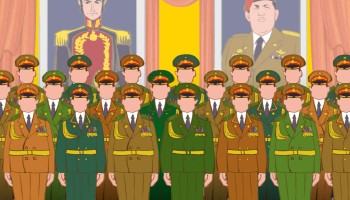José González Valencia is a man of many names.
Among his comrades in the Cartel Jalisco Nueva Generación, one of the most powerful and violent drug cartels in Mexico, he is known as Chepa, Santy, and El Camaron, or the Shrimp.
He is also allegedly a member of the cartel’s finance and money-laundering group, Los Cuinis, named after a fast-breeding Mexican squirrel.
But in Bolivia, where he spent over two years evading justice, he was known as Jafett Arias Becerra, a respectable cattle rancher.
In this guise, the powerful drug lord escaped the notice of authorities in the United States, Mexico, and Bolivia, though the U.S. State Department issued a reward of up to $5 million for information leading to his capture. He obtained a Bolivian identification card, bought land in an exclusive residential complex, and became a successful breeder of Zebu cattle, OCCRP has learned.
González Valencia flew in and out of Bolivia multiple times in 2016 and 2017, raising questions about how it was so easy for him to live comfortably as a wealthy cattleman when he was wanted by the United States on charges of conspiracy to distribute large amounts of cocaine.
Bolivian authorities blame Mexico for the lapse, but also admit their fertile Santa Cruz region, known as “Bolivia’s barn,” is a popular hideout for drug traffickers on the lam. They acknowledge that they need to corral criminals like the Shrimp who find safe haven there.
A Cartel in the Crosshairs
Cartel Jalisco Nueva Generación (CJNG) has alarmed authorities in the United States and Mexico with its brutal tactics and rapid growth since it was formed in 2011.
Based in Guadalajara, the capital of the Mexican state of Jalisco, CJNG is behind some of the most notorious drug crimes of the past decade, including the 2011 torture and massacre of 35 rival cartel members in Veracruz and the downing of a military helicopter with a rocket-propelled grenade in 2015. The cartel even uses cannibalism as an initiation rite for new members.
CJNG now has a presence in most of Mexico and connections in the rest of Latin America, the United States, Asia, Europe, and Australia. It is responsible for trafficking at least five tons each of cocaine and methamphetamine into the U.S. every month, according to former U.S. Attorney General Jeff Sessions.
Last October, Sessions announced new measures targeting CJNG, including hefty rewards for the capture of its leaders and economic sanctions against several of the Cuinis. He also unsealed indictments of 11 alleged members of the cartel, including Jose González Valencia.
Sessions called CJNG one of the five most dangerous transnational criminal groups in the world.
“We are hitting them from all sides and with every weapon we have,” he said at a news conference. “They are in our crosshairs. This cartel is a top priority.”
Like many criminal organizations, CJNG is a family affair. José González Valencia — the man who lived as a cattle rancher in Bolivia — is the brother-in-law of its leader, Nemesio Oseguera Cervantes, who is also known as “El Mencho.”
The cartel’s rise and expansion are due largely to Los Cuinis, which according to U.S. officials is dominated by the González Valencia family.
El Mencho’s wife, Rosalinda González Valencia, and three of her brothers, José, Gerardo, and Abigael, played a dominant role in establishing and operating Los Cuinis, with Abigael serving as “El Cuini” — the top squirrel.
In an interview with the Mexican news magazine Proceso in 2015, a U.S. Drug Enforcement Administration official described El Cuini as an intelligent trafficker whose diversification strategy differentiates CJNG from other cartels.
"The ‘Cuini’ focused on partnering with drug traffickers and narco rebels of Colombia and other South American countries to sell cocaine and other drugs in Europe, without regard to the United States. That made a big difference in terms of profits earned," he said.
"'El Cuini' and 'El Mencho' understood that there was more risk ... if they were to compete with other cartels for the U.S. market," another official told the magazine.
José González Valencia took over cartel finances after his brother Abigael was arrested in February 2015, according to the Center for Investigation and National Security, a Mexican intelligence agency. He was also allegedly responsible for providing security for the leader, El Mencho, making alliances with criminal groups in Asia and Europe, and establishing relationships with arms traffickers in the U.S. and Central America, Mexican newspaper La Jornada reported.
But despite his high profile, José González Valencia moved easily from Guadalajara to Bolivia, entering the country for the first time later that year. His ticket was a Mexican passport he had obtained in Guadalajara in 2013 under the name Jafett Arias Becerra.
It is unclear what he did to obtain that document, but it bought him years of freedom. In 2016, the year after he first came to Bolivia, he used it to obtain a Bolivian ID for foreigners. He was also granted a temporary stay valid for one year and applied for a second that would have been valid until March 2019.
Court records show American officials had been aware of his alias since January 2016. But according to Bolivian authorities, Interpol never issued any alerts for “Jafett Arias Becerra.”
González Valencia was able to travel between Bolivia and Brazil without raising suspicions at least three times: in October 2016, March 2017, and December 2017, according to border logs obtained by OCCRP’s Brazilian partner, Epoca Magazine.
Neither Interpol nor the U.S. Department of Justice would comment on the lapse.
The Narco Cattleman
As “Jafett Arias Becerra,” the drug trafficker was able to live freely, in the Bolivian city of Santa Cruz de la Sierra.
He later told Brazilian officials he chose Bolivia because he wanted to make a fresh start in a peaceful place, not to hide from the law.
“I wanted to live in a city with tranquility, in another country where nobody knew me,” he said.
On arriving, he made connections in a new field, cattle breeding, in a place where beef is big business.
“We have around 2.5 million inhabitants in the department of Santa Cruz, so basically the number of cattle is three times bigger than us,” said Jose Alberti, a Bolivian economist.
In October 2016, Gonzalez Valencia purchased a 1,355 square-meter plot in Urubo, an exclusive residential area of Santa Cruz’s capital, Santa Cruz de la Sierra, according to documents obtained by OCCRP partner El Deber. A local real estate expert said such a purchase, in a development that features tennis courts and a semi-Olympic pool and touts itself as “an architectural landmark without comparison,” would have cost around $200,000 at the time.
The following month, according to documents obtained by OCCRP, González Valencia joined Bolivia’s premier cattle breeding association, the Bolivian Association of Zebu Breeders (ASOCEBÚ).
A large proportion of the livestock cattle in Bolivia are Zebu, a relatively small cow with a large shoulder hump, originally developed on the Indian subcontinent but well-adapted for other hot environments. Alberti said that prospective members of a guild such as ASOCEBÚ must submit extensive documentation proving their cattle breeding credentials, describing the requirements as a “filter” to prevent drug money from entering Bolivia's cattle industry.
The admission requirements include a property title and a map of the applicant’s cabaña, or cattle-breeding ranch, and a police clearance certificate. Foreign nationals must also submit an official Bolivian identity card.
The whereabouts of González Valencia’s cabaña, if he has one, are unclear. But in April 2017, he showed four of his cows at the International Agricultural Fair of Santa Cruz, Bolivia’s largest agricultural exposition, as a representative of a cabaña called La Luz. He also showed livestock at two other major fairs that year, and was featured as one of the best exhibitors in two categories.
Fernando Baldomar, the ASOCEBÚ general manager, confirmed that González Valencia fulfilled all the group’s requirements, including submission of an authentic Bolivian government ID. But he said the association doesn’t release information related to individual cabañas.
González Valencia could not be reached for comment. His lawyer answered initial questions about his client’s extradition process but did not respond to subsequent calls. Reporters were unable to obtain any comment about González Valencia’s cattle business.
Cattle as Camouflage
The most unusual thing González Valencia did in Bolivia might have been joining ASOCEBÚ.
Alberti, the Bolivian economist, said foreign ranchers of dubious provenance rarely join breeding associations or formally register cattle, steps that make it easier to track them down.
Aside from this, González Valencia was far from the first to hide in this manner. Speaking on condition of anonymity due to security concerns, a Bolivian anti-narcotics agent said that foreign narcos commonly pose as cattle ranchers in the country. He said they usually establish ranches in remote areas where they can set up clandestine airstrips and drug laboratories.
In January, Mario Morfulis, an Argentinian who has been wanted by Interpol since 2013, was arrested in Bolivia, where he was living as a rancher. He was a member of the Castedo clan, a drug trafficking organization operating in the north of his home country. According to the Argentine authorities, Morfulis was a “nationalized Bolivian” who used forged documents to disguise his identity.
In 2017, an armored car carrying $1.3 million was robbed near the eastern Bolivian town of Robore. The authorities arrested Mariano Tardelli, a leader of the Brazilian drug gang Primeiro Comando da Capital, saying he had been hiding out as a cattleman in Santa Ana, a town in eastern Bolivia. There, he maintained two large properties called “Laura” and “Alborada” and reportedly ingratiated himself with locals by throwing large parties with live bands, giving away cattle, and hiring villagers to work for him.
Carlos Noel and Héctor Fabio Buitrago, cousins of Colombian drug trafficker and paramilitary leader Martín Llanos, were arrested in 2011 in Santa Cruz de la Sierra, where Carlos Noel was seen as a "prosperous Colombian cattle rancher and an extraordinary businessman," according to Colombian newspaper El Tiempo.
And Maximiliano Dorado, one of Brazil’s most wanted narcos, gained Bolivian citizenship and had a cattle ranch in Santa Cruz until he was expelled from Bolivia in 2010. His brother, Ozzy Dorado, also a cattle rancher and farmer, was arrested in Bolivia on charges of criminal organization and legitimization of illicit profits in 2013.
According to Joadel Bravo, a former counternarcotics prosecutor in Bolivia, Santa Cruz is an especially attractive destination for active traffickers because its economy is growing fast and it is near El Chapare, a region where there are many coca plantations. It also borders Brazil and Paraguay, both common destinations for drug trafficking.
Drug Trafficking in Bolivia
President Evo Morales’ expulsion of the Drug Enforcement Administration from the country in 2008 and the lack of equipment such as radar and helicopters have also made Bolivia more vulnerable to drug traffickers, according to Joadel Bravo, a former counternarcotics prosecutor. Corruption in the judiciary and police, insufficient judicial resources, and political interference also make it difficult to fight the drug trade, according to the US Department of State International Narcotics Control Strategy Report.
In an interview with El Deber, Bolivian Government Minister Carlos Romero acknowledged that the country’s agriculture and livestock sectors had become useful havens for traffickers.
“These people have taken ‘refuge,’ in quotation marks, in Bolivia and have faked business activity,” he said. “Or, in fact, they have conducted business activity, probably with the illicitly obtained resources of the drug trafficking activity and in the hope of being able to launder the money obtained from activities apparently of productive entrepreneurship, be it agriculture, livestock preferably.”
But he said the government was working to make the country less hospitable to criminals.
The Regional Counter-Narcotics Intelligence Center, an international intelligence sharing platform established in Santa Cruz de la Sierra last May with UN support, is building a database of money flows and criminal organizations, and the government now uses a new automatic fingerprint identification system to establish peoples’ identities, Romero said.
At the inauguration of the center, the representative of the United Nations Office of Drugs and Crime in Bolivia, Thierry Rostan, highlighted the “strategic position of Bolivia and especially of Santa Cruz de la Sierra as an international drug transit point.”
Corruption in Santa Cruz
A recent high-profile case shows how drug trafficking has already corrupted Bolivia’s police forces. In March, two senior Santa Cruz police officials were suspended and detained for alleged drug trafficking.
In January, Rostan again warned of an increase in the number of foreigners entering the country to take part in the drug trade. Between 2017 and 2018, 469 foreigners were detained in Bolivia for drug trafficking, including 142 Colombians, 121 Peruvians, 83 Argentines, and 58 Brazilians.
Rostan also recommended more coordination between government agencies to identify traffickers before they entered Bolivia.
Colonel Maximiliano Dávila, director of Bolivia’s Special Force to Fight Drug Trafficking, did not respond to a request for comment.
Now fenced in
González Valencia was finally caught in December 2017 — not in Bolivia, but in Brazil. He had flown there with a Bolivian friend, Mario Genaro Soljancic Fernandez, a vendor of veterinary products for cattle.
González Valencia was planning to meet his wife and children, who live in the United States, for a holiday in the tourist hub of Taíba on Brazil’s northeastern coast. Under Soljancic’s name, they rented a car and a seaside villa, complete with a basketball court and a small swimming pool, for 15 days.
In response to a U.S. arrest request passed on by officials in Brasilia, police in the city of Fortaleza identified the rental car and then spent days monitoring security camera video until they found it, said Aldair da Rocha, the officer in charge of the operation. González Valencia was arrested at the stores in front of Beach Park, a nearby water park and tourist resort, on Dec 27, 2017. He was carrying his Bolivian ID card.
Fortaleza, Brazil’s new cocaine hub
Fortaleza, population 2.65 million, is one of the largest cities in northeast Brazil and its pristine Atlantic beaches make it a prime tourist destination.
The revelation that a wanted drug trafficker had lived undetected in Bolivia for nearly two years caused a stir.
The official responsible for immigration in Santa Cruz, Henry Baldelomar, blamed Mexico for “weakness of the control of his identity document."
Mexican officials have not responded to repeated requests for comment.
Bolivia’s General Directorate of Immigration said Interpol never issued any alerts for “Jafett Arias Becerra.” The directorate didn’t respond to multiple interview requests. After González Valencia’s arrest, it said in a written statement that he was granted a “temporary stay for one year for family” justified by his “economic dependence” and “sentimental relationship with a Bolivian citizen.”
However, González Valencia is not known to have had a relationship with any Bolivian, and on arrival told authorities he didn’t know anyone there. After his arrest he admitted only to using a fake passport.
“I never participated in drug trafficking, anywhere,” González Valencia told a Brazilian judge in halting Portuguese.
He is now serving a sentence for using a false document and awaiting extradition to the United States in Brazil’s Federal Penitentiary in Mossoró, a maximum-security lockup for particularly dangerous inmates.
In February 2018, the U.S. Drug Enforcement Administration interviewed González Valencia. His lawyer, Otoniel Maia de Oliveira Júnior, said his client denied being the person they were seeking. The DEA declined to comment.
Brazil’s Federal Supreme Court recently extended his prison term, citing the pending extradition, the “extremely high risk of the individual,” and his links to the CJNG.
According to real estate documents obtained by OCCRP partner El Deber, González Valencia still owned his Bolivian property as of March.










